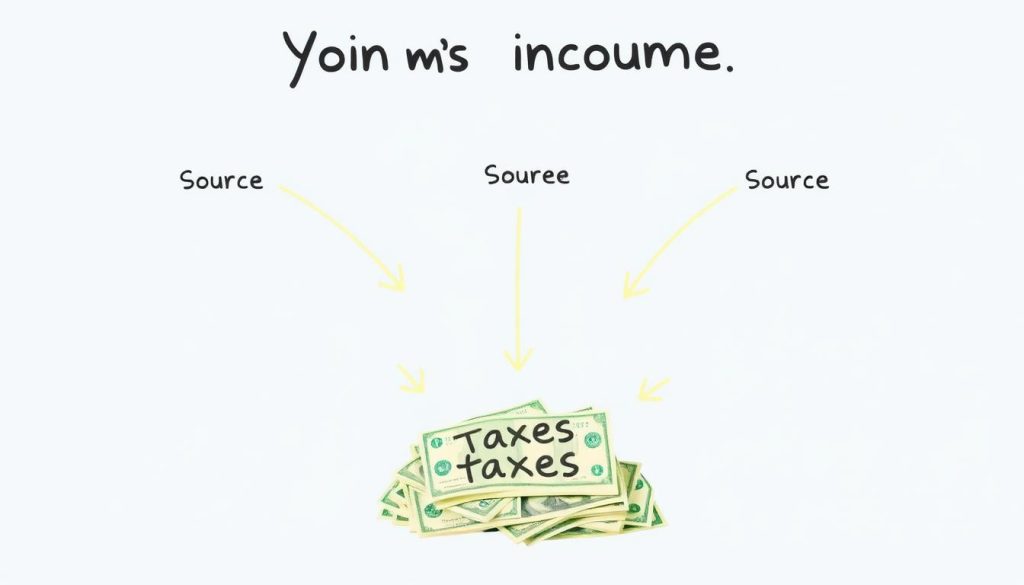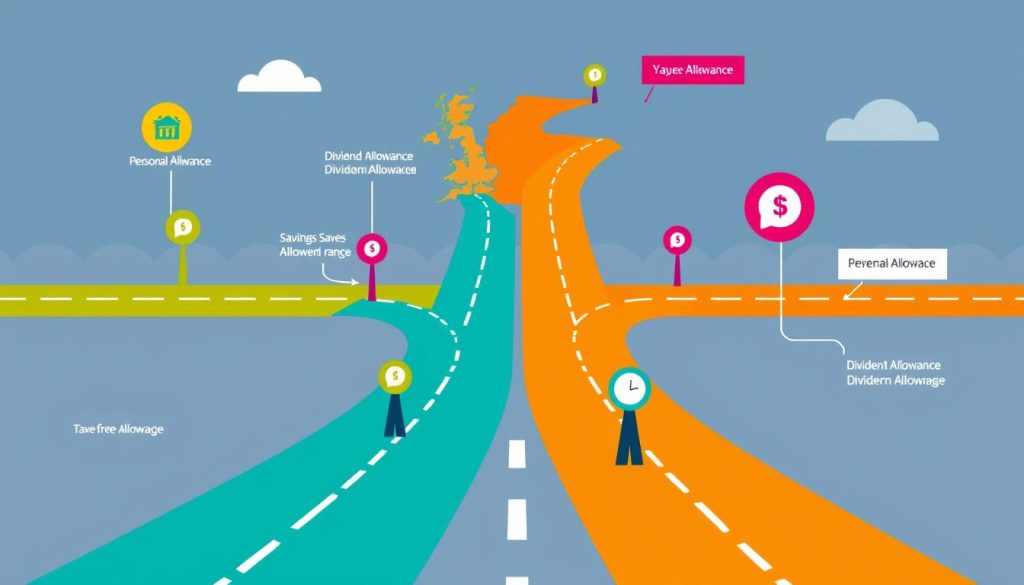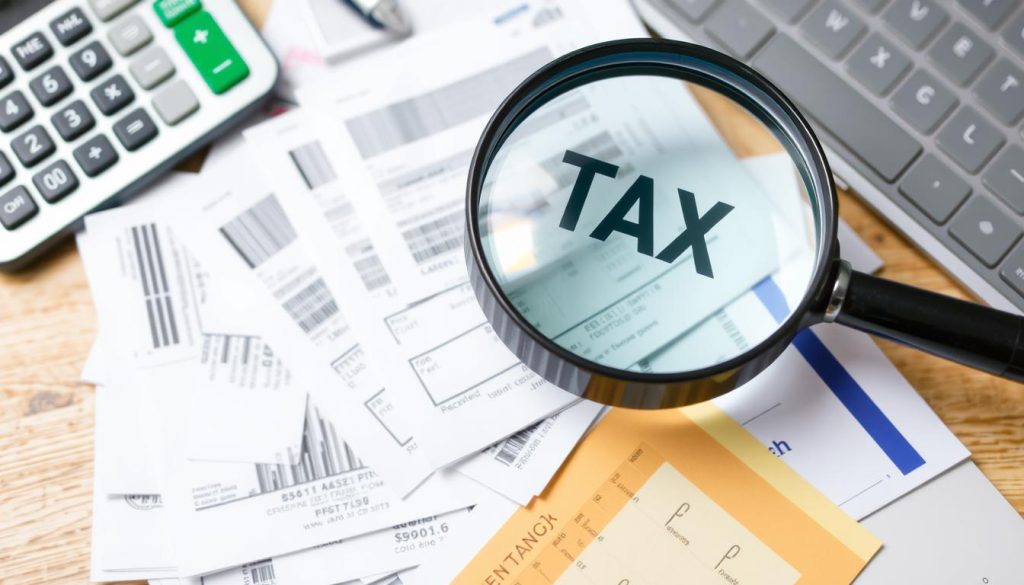Do you know about the hidden potential in UK tax laws that can boost your savings?
The world of tax regulations is always changing. Knowing how to deal with these changes can unlock big financial benefits. If you’re trying to get more from your tax returns or improve tax efficiency, our guide is here to help. We have strategies tailored just for you.
By reading our article, you will learn many ways to save on taxes. You’ll get to know the basics of income tax, the benefits of ISAs, and how to use pension contributions to your advantage. Our expert tips will make sure you’re set to increase your savings.
Let us show you how to deal with the UK tax system’s complex rules. With our help, you can look forward to a future where you’re more secure financially.
Understanding the Basics of Income Tax

The UK tax system is complex, but knowing the basics is essential. This guide covers the key points of income tax, including how it’s calculated and the different tax bands. Understanding these can help you manage your finances better.
What is Income Tax?
Income tax is what you pay on what you earn. It applies to things like wages, pensions, and business profits in the UK. Knowing about this is key to handling your money right and staying within the law.
How Income Tax is Calculated
Calculating tax means working out your taxable income and applying the right rates. In the UK, you do this yourself under the self-assessment system. The steps include:
- Adding up all the money you make.
- Deducting any allowances and allowable expenses.
- Using the tax bands to figure out your tax.
Getting to grips with these steps helps you work out what you owe and avoid fines.
Different Income Tax Bands
The UK has different tax bands – the more you earn, the more tax you pay. The main bands are:
- Basic Rate: For the first bit of your income.
- Higher Rate: For earnings above the basic rate, up to another limit.
- Additional Rate: For the very top earnings.
Knowing these bands helps you figure out your taxes and save money where you can. Being clued up means you can plan your finances smartly and understand your tax bills better.
Tax-Free Allowances in the UK

The UK tax system offers various allowances to reduce your taxable income. These help you save money. We’ll look at key allowances like the Personal Allowance, Marriage Allowance, and Blind Person’s Allowance.
Personal Allowance
You don’t pay tax on income up to a certain amount each year. This year, you can earn £12,570 tax-free. This Personal Allowance is a major benefit for UK residents. You might get more if you’re eligible for other allowances.
Marriage Allowance
Marriage Allowance lets you transfer some of your allowance to your partner. It’s great if one earns less than the threshold. Up to £1,260 can be transferred, saving tax for couples.
Blind Person’s Allowance
If you’re registered as blind, you get an extra allowance. This year, it’s £2,600 on top of the Personal Allowance. It means blind individuals pay less tax. You must meet certain UK tax rules to claim it.
ISAs: Tax-Efficient Savings Accounts

Individual Savings Accounts, or ISAs, help maximise your savings without paying tax in the UK.
Types of ISAs
Different ISAs meet various needs. Here are the main kinds:
- Cash ISAs: Perfect if you want to save safely. They offer interest without taxing it.
- Stocks and Shares ISAs: Good for those ready to risk for potentially higher gains.
- Lifetime ISAs: These help save for retirement or buying your first home, with extra government money.
- Junior ISAs: Let parents save for their kids’ futures tax-efficiently until they’re 18.
Benefits of ISAs
ISAs aren’t just about tax savings. They have many benefits:
- Tax-Free Interest and Dividends: You don’t pay UK tax on interest or dividends from your ISAs.
- Flexibility: You can switch ISAs or move providers without losing tax-free benefits.
- Higher Contribution Limits: You can save a lot each year, growing your money tax-free.
- Accessibility: There’s an ISA for everyone, no matter your risk appetite or saving goal.
Using ISAs wisely can help you reach your financial goals with the benefit of saving tax. Knowing about the different types and benefits lets you make choices that suit your finances.
Capital Gains Tax Reliefs

Understanding capital gains tax reliefs can make a big difference. There are many reliefs that help reduce how much you have to pay. By using these, both investors and regular taxpayers can save money.
Annual Exempt Amount
The annual exempt amount is a limit under which you don’t pay capital gains tax. For the 2022/2023 tax year, it’s £12,300 for individuals and personal representatives, and £6,150 for most trustees. It’s important to use this allowance every year, as you can’t carry it forward.
Gift Relief
Gift relief allows you to delay paying capital gains tax on gifts, if certain conditions are met. It’s mainly for business assets, shares, and securities. The person getting the gift takes on the original cost, which helps avoid capital gains tax right away. But, you must tell HM Revenue and Customs about the gift within four years.
Entrepreneurs’ Relief
Entrepreneurs’ relief, now called Business Asset Disposal Relief, lowers the capital gains tax rate to 10% on eligible business sales. This relief has a lifetime limit of £1 million. It’s for sole traders, business partners, or those owning at least 5% of a company. To fully benefit, make sure you meet all conditions before claiming it.
Making the Most of Pension Contributions

Putting money into a pension is great for a comfy retirement and offers tax perks. You can choose between workplace pensions or personal plans, both offering tax-efficient ways to save. Knowing how tax relief works can boost your retirement funds a lot.
Workplace Pensions
Employers provide workplace pensions, a key method of saving for later life. They can be either defined benefit or defined contribution schemes. With employer contributions, your retirement savings grow faster. It’s wise to up your pension input whenever you can for more benefits.
Personal Pensions
Personal pensions are another solid choice for building your retirement stash. Options include stakeholder pensions and SIPPs, allowing for varied investment picks. Steady contributions and the power of compound growth make personal pensions essential for diverse retirement planning.
Tax Relief on Contributions
The tax relief on pensions is a big advantage. This system puts the tax money you would have paid directly into your pension instead. For basic-rate taxpayers in the UK, you get £20 from the government for every £80 you put in, making your total contribution £100. If you pay a higher rate, you can get even bigger tax breaks.
Incorporating Tax-Efficient Investments

Want to grow your investments and get tax benefits? Look into tax-efficient investment options. We will talk about two key schemes: the Enterprise Investment Scheme (EIS) and the Seed Enterprise Investment Scheme (SEIS). They offer great tax breaks to help new businesses get funding.
Enterprise Investment Scheme (EIS)
The EIS helps small, high-risk companies get money by giving tax relief to their investors. If you invest, you can reduce your income tax by 30% of your investment, providing you keep the shares for three years. Selling EIS shares after three years? You won’t pay Capital Gains Tax. This scheme benefits both companies and investors.
Seed Enterprise Investment Scheme (SEIS)
SEIS focuses on new companies and offers even bigger tax breaks than EIS. You get a 50% tax relief for investing up to £100,000 each year. Also, you won’t pay Capital Gains Tax on profits from SEIS shares if sold after three years, up to half of the gains. You can even reduce your income tax bill if you lose money on your SEIS shares. It’s a great option if you want to invest in new companies with potential.
Adding these schemes to your investment plan can be rewarding. EIS and SEIS offer ways to save on taxes while earning possible high returns. It’s wise to talk to a financial advisor, though. They can help you see how these options fit with your financial goals.
National Insurance Contributions

National Insurance Contributions (NICs) are key in the UK, supporting vital social security benefits. Knowing about National Insurance helps you follow rules and get the most from contributory benefits.
NICs come in different classes, based on work status and earnings. Each class has its rates.
Workers see NICs taken from their pay. This way, both they and their employers contribute correctly. Those who are self-employed pay through self-assessment, supporting their social security too.
- Class 1: Contributions from employees and employers, based on earnings.
- Class 2: Flat-rate contributions for self-employed individuals.
- Class 3: Voluntary contributions to fill in gaps in contribution records.
- Class 4: Additional contributions for self-employed individuals with higher profits.
It’s crucial to calculate and pay on time. Otherwise, you might face fines or lose some contributory benefits. These benefits include the State Pension and Maternity Allowance.
National Insurance Contributions are crucial for the UK’s welfare. Being informed about your NICs means you’re ready for financial security later on.
Dividend Tax Allowance

The dividend tax allowance matters a lot for investors and company directors who get dividends. Knowing how to properly use this allowance can lead to big financial wins.
What is Dividend Tax Allowance?
The dividend tax allowance lets you earn a certain amount of dividend income tax-free. It helps you keep more of your investment earnings without paying tax on them.
Current Rates
The allowance is £2,000 at present. Dividends over this limit are taxed according to your tax rate:
- Basic rate taxpayers: 7.5%
- Higher rate taxpayers: 32.5%
- Additional rate taxpayers: 38.1%
It’s vital to keep up with rate changes. They can impact your dividend tax plans.
Strategies for Maximising this Allowance
There are smart ways to make the most of this allowance. Here are some top tips:
- Splitting dividends: Share dividends with family members in lower tax bands to reduce tax owed.
- Utilising personal tax bands: Make sure to use all your personal allowances and tax bands to lower dividend tax.
- Reinvesting dividends: Putting dividends back into ISA accounts can keep future earnings from being taxed.
By adjusting these strategies to fit your needs, you can save more on taxes.
Utilising Gift Aid
Gift Aid is a scheme supported by the government. It allows charities to claim an extra 25p for each £1 given, with no extra cost to the person giving. This makes donations worth more and helps both those who give and the charities. Here, we will see how Gift Aid functions, what it offers, and what’s needed for donations to qualify.
How Gift Aid Works
If you donate to a charity and pay UK tax, you can choose Gift Aid. By doing this, charities can ask HMRC for the basic rate tax back on your donation. This raises the value of the donation by 25% without costing you more. This way, charitable gifts do more good.
Benefits of Gift Aid
Gift Aid increases the value of gifts to charities, letting them do more. For those who donate, it means tax relief. If you pay more than the basic tax rate, you can get money back on donations. Charitable giving becomes beneficial for both sides.
Conditions for Gift Aid
To be part of Gift Aid, certain rules must be followed:
- You need to have paid enough Income or Capital Gains Tax in the year to cover what the charity reclaims.
- The donation must go to a charity or a community amateur sports club (CASC) that’s registered.
- You have to give a Gift Aid declaration to the charity, which they keep as proof to get the tax back.
By meeting these criteria, both donors and charities gain from Gift Aid.
Business Expenses: What Can You Claim?

Knowing which business expenses you can write off is key to your financial health. It helps you lower your taxable profit. This makes your business more efficient and profitable.
Allowable Expenses
Some costs are necessary for your business to run. These are called allowable expenses. Common examples include:
- Office supplies and equipment
- Utility bills for your workspace
- Travel expenses related to business activities
- Marketing and advertising costs
- Professional services, including accountancy fees
- Insurance premiums
Remember, personal expenses can’t be claimed. Only costs essential to your business qualify for tax deductions.
Records to Keep
To back up your tax claims, keeping good records is essential. You need detailed receipts, invoices, and transaction records. You should keep:
- Bank statements and credit card statements
- Receipts for all business purchases
- Travel expense proofs like tickets and mileage logs
- Sent and received invoices
- Payslips and payroll records
- Utility bills and rent statements
Good records prove your deductible expenses in tax audits. This protects your business from potential issues with HMRC (Her Majesty’s Revenue and Customs).
Understanding Attractive Tax
Attractive taxation means tax systems with features that help people and businesses lower their tax payments legally. These features can be special tax reliefs, deductions, or lower rates that make certain financial choices more appealing.
There are many ways to use attractive taxation to your advantage. By creating a plan that uses these tax benefits, taxpayers can lessen their tax load and save more money.
In the UK, there are several key aspects of attractive taxation that can help design effective tax-saving strategies:
- Tax Reliefs: Taking advantage of available tax reliefs for pension contributions or investments in things like the Enterprise Investment Scheme (EIS).
- Tax Allowances: Using tax-free allowances on personal income, dividends, or capital gains to your benefit.
- Preferential Tax Rates: Benefiting from lower rates on capital gains or dividends, which are less than the usual income tax rates.
To make the most of tax optimisation strategies, it’s vital to keep up with changes in laws. Understanding all available allowances and reliefs is crucial. By aligning financial choices with these tax benefits, one can enjoy the best elements of attractive taxation.
Tax Planning for Self-Employed Individuals
Understanding self-employed tax planning can cut down your taxes and boost your financial health. We will explore important tax deductions, the need for careful record-keeping, and high-level tax strategies. These can all help better your tax situation.
Key Tax Deductions
Self-employed people can use many tax deductions to lower their taxable income. You can deduct costs for business travel, office expenses, professional fees, and goods sold. These tactics help you keep more money legally by ensuring you claim rightful business costs.
Record Keeping
Good record keeping is key for self-employed tax planning. By storing detailed records of receipts, invoices, and financial statements, you make tax deduction claims easier. This also helps avoid problems with HMRC. Digital tools can help keep your paperwork in order, making your tax returns accurate and complete.
Advanced Tax Planning Strategies
For the self-employed, advanced tax strategies might mean setting up as a limited company or using pension contributions for tax relief. You could also explore sharing income with partners or family. These clever tactics can save you a lot of money over time and improve your tax situation.











